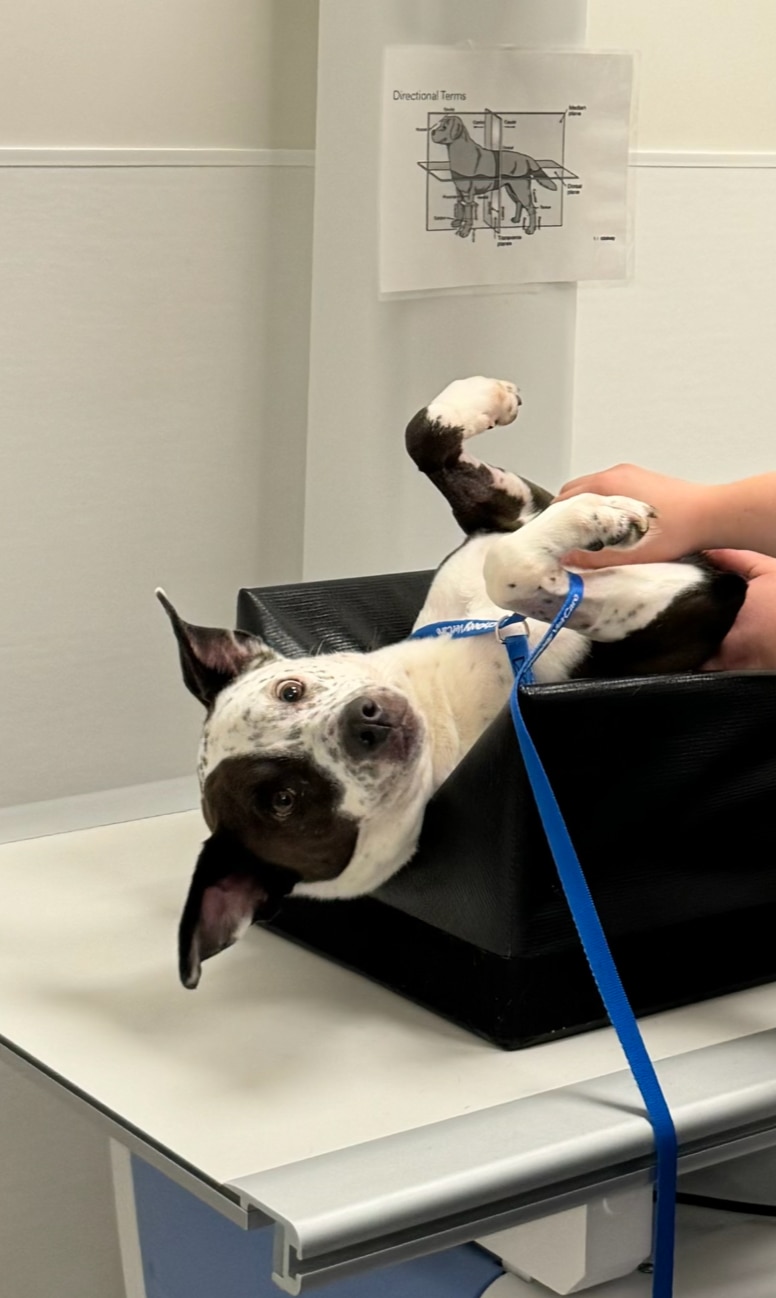X-Rays for Dogs
Capuski/iStock / Getty Images Plus via Getty Images
What Are X-Rays for Dogs?
X-rays, also known as radiographs, are an essential component of veterinary medicine. X-rays for dogs allow us to see inside a dog’s body, detect disease, and evaluate organs.
X-rays, put simply, are 2D images of a 3D object, a type of electromagnetic radiation produced when electrical energy from electrons is converted into X-rays within a specially designed tube.
During an X-ray, the dog is positioned on the table between the tube and the X-ray film or cassette. The electrical energy passes through the dog and is absorbed by tissues, resulting in an image displayed on a screen.
The denser the tissue, such as bones, the more energy is absorbed, resulting in a whiter image on the screen. Organ tissues like the liver and spleen are less dense, so they appear gray. Air, having no density and thus absorbing no energy, appears black.
X-rays for dogs allow us to see inside a dog’s body, detect disease, and evaluate organs.
X-rays are invisible and painless and are a routine occurrence within veterinary hospitals. X-rays for dogs are relatively inexpensive, are non-invasive, and can provide a quick and real-time diagnosis.
On the downside, exposure to X-rays poses potential hazards such as the risk of tissue damage and the development of radiation-induced health issues over time.

While not all dogs require sedation for an X-ray, sedation can help shorten the exposure time by reducing the dog’s movement during imaging. This helps prevent blurry or distorted images, which could otherwise necessitate additional X-rays and radiation exposure.
Types of X-Rays for Dogs
X-rays for dogs can visualize nearly all areas of the dog’s body and are categorized into the following groups:
-
Skeleton—Bones, including joints within the skeletal structure, spine, and skull
-
Thorax (chest)—Lungs, heart, trachea, ribs, esophagus, diaphragm
-
Abdomen—Gastrointestinal (GI) tract, spleen, liver, kidneys, bladder, diaphragm
-
Dental—Teeth, jawbones, and associated structures
Recommended Products
Why Would a Dog Need an X-Ray?
X-rays for dogs are an extremely useful diagnostic tool. A wealth of information can be obtained. Your vet may recommend an X-ray based on potential underlying health issues in your dog including:
-
Trauma
-
Foreign objects, including GI obstruction
-
Fractured bones
-
Bladder stones
-
Muscle, joint, or ligament tears; arthritis; hip dysplasia
-
Determining if surgery is necessary
Risks of X-Rays for Dogs
Radiation Exposure
The main risk of X-rays for dogs is radiation exposure. Radiation can have harmful effects, and limiting exposure is critical.
One way to mitigate radiation risk is to sedate the dog, as this allows proper positioning with minimal exposure time, reduces the number of X-rays needed, and minimizes exposure for the veterinarian or veterinary technician.
The goal is to obtain as much diagnostic information as possible while minimizing exposure. Any amount of radiation will have some effect on the dog, and some damage to cells and DNA can occur. However, X-rays for dogs pose minimal risk overall, and the amount of radiation used is low.
Other risks, though minimal, can include errors in interpretating the results and misdiagnosis, especially with subtle changes. Therefore, it’s always best to have the X-rays reviewed by a board-certified radiologist.
X-rays for dogs overall pose minimal risk, and the amount of radiation used is low.
Technical errors can also render an X-ray blurry, distorted, or difficult to interpret, which may necessitate repeating the X-ray study.
Benefits of X-Rays for Dogs
X-rays for dogs can detect issues that other tests may miss.
For example, a dog who ingested a foreign object may have completely normal bloodwork and a normal physical exam despite a history of vomiting and decreased appetite.
However, upon taking an X-ray, the object is often clearly visible within the stomach, enabling prompt surgical intervention.
Effectiveness of X-Rays for Dogs
Due to their design, X-rays are particularly useful for examining bones and organs and assessing areas with varying tissue densities, such as the chest.
However, there are some limitations when evaluating certain tissues like ligaments and tendons. For example, X-rays of a dog’s knee when a cranial cruciate ligament rupture is suspected can provide good supportive information. But they cannot definitively diagnose damage to the cruciate ligament, the meniscus, or both.
Additionally, X-rays can be more challenging if your dog is overweight or underweight, and they offer limited value in examining the head due to the complexity and density of bones within the skull.
The Cost of X-Rays for Dogs
The cost of X-rays for dogs varies, but pet parents can expect to pay anywhere from $200 to $500 or more, particularly if sedation, general anesthesia, or additional images are needed.
Some veterinary facilities may base their charges on the size of the dog or the location of the X-ray (e.g., dental vs. abdomen), while others may have a fixed rate regardless of the view.
Pet insurance companies may cover some or all the costs unless specifically stated otherwise in their terms and conditions. Be sure to review your policy thoroughly.
Preparing Your Dog for X-Rays
Fortunately, there isn’t much required in preparing your dog for an X-ray. If medication such as a sedative like trazodone or gabapentin is prescribed, follow your veterinarian’s recommendations. If X-rays are scheduled, you may be asked to not feed your dog for a few hours beforehand in case sedation is needed.
X-rays are invisible and painless and are a routine occurrence within veterinary hospitals. X-rays for dogs are relatively inexpensive, are non-invasive, and can provide a quick and real-time diagnosis.
In the hospital, dogs are positioned on their side, back, or sometimes belly and appropriately restrained. Chemical sedation, sandbags, foam wedges, troughs, or tape may sometimes be used to put your pet in the proper position and minimize the radiation exposure time.
The actual X-ray procedure itself takes only a second, and from start to finish the procedure usually takes just a few minutes.
Complications of X-Rays for Dogs
Proper positioning is crucial for a diagnostic X-ray, requiring dogs to be adequately restrained and positioned. If your dog struggles or is in pain during an X-ray, additional images may be necessary, exposing them (and the veterinary staff) to more radiation. In this case, sedation may be recommended.
As limbs must be correctly positioned, your dog may experience some soreness afterward, especially if they have any underlying arthritis.
Alternatives to X-Rays for Dogs
If an X-ray is recommended, your veterinarian has weighed the risks and benefits, deeming it important for the proper diagnosis and treatment for your dog. However, for dogs in critical condition, it’s often preferred to stabilize them as best as possible before taking an X-ray, as the stress of the procedure could exacerbate their condition.
Contrast Studies
X-rays for dogs are almost entirely digital, allowing the image to be captured and viewed on a computer screen in real time.
Contrast studies, while less common, involve the administration of contrast agents to enhance visualization of certain structures or conditions. They may be ordered if the X-ray is inconclusive or if there are concerns regarding an obstruction, foreign body, bladder rupture, or certain neurologic diseases.
Contrast agents are not without risks, as complications such as hypotension, anaphylaxis (shock), or infection can occur.
Be sure to speak with your veterinarian about the risks and benefits of contrast radiography compared to alternatives such as ultrasound, MRI, and CT.
CT, MRI, and Ultrasound
Alternatives such as CT scans, MRI scans, and ultrasound may be considered and necessary at times to obtain an accurate diagnosis.
However, these procedures often require general anesthesia or sedation and are more labor-intensive and costly. Additionally, they are typically only available at specialty vet hospitals.
X-Rays for Dogs FAQs
Are X-rays for dogs worth it?
As a cost-effective, non-invasive means to obtain critical diagnostic information, X-rays are most definitely worth it. While radiation is involved, the overall frequency and level of radiation exposure to your dog are typically quite low.
References
Thrall D. (2007). Textbook of Veterinary Diagnostic Radiology. Saunders.




